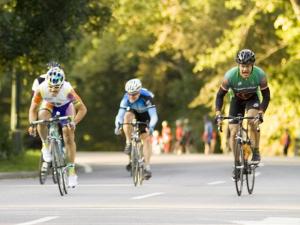
I recently had the opportunity to try out Greg Choat’s Retül bike fit (Choat runs EnduroCoach, a New York coaching and bike fitting business for cyclists, triathletes, and other endurance athletes). Since my road bike’s seatpost is permanently fused to the frame, I went for a TT bike fit. The $300 three hour fit session consists of two major components. The first is the Retül 3d imager, a millimeter accurate device which evolved from a brain surgery guidance system. Three cameras mounted in a 24" bar triangulate the location of infrared emitting LED’s mounted on the rider, similar to motion capture systems used in video games and animation. Unlike passive systems that use reflectors to redirect light back to the cameras, the Retül system uses active LED’s, so it doesn’t have to be used in complete darkness.
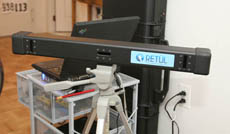
With markers on the wrist, shoulder, hip, knee, ankle, heel, and forefoot, an almost real time stick figure of the rider appears on a laptop. 30 second runs are recorded while pedaling on a trainer, and a summary of the rider’s angles are recorded. Unlike static measurements, angles are measured under load, and so are more reflective of race conditions. The primary view is from the side (only one side of the rider is measured at a time), but there’s also a secondary front view of the lateral drift of the rider’s knee.
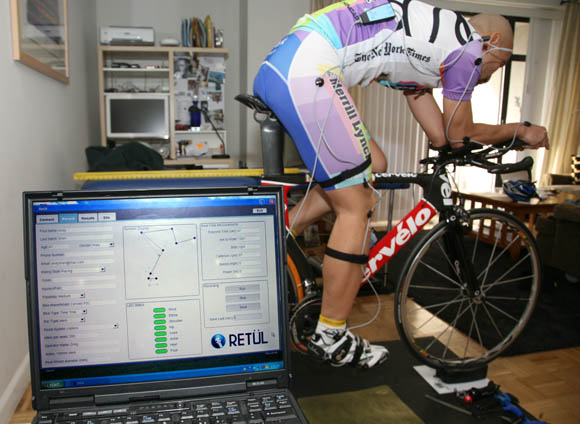
The second component of the fit is Choat’s expertise. As stated on Retül’s site, Retül is an imaging tool, not a fit philosophy. While it can generate valuable data, it’s still up to the fitter to interpret and make use of the data. Choat, one of only four level 2 USA Cycling coaches in New York, recently spent time working with biomechanist Todd Carver in Denver, Colorado. Carver is considered a bike fit guru and has extensive experience working with 3D motion capture for bike/rider positioning.
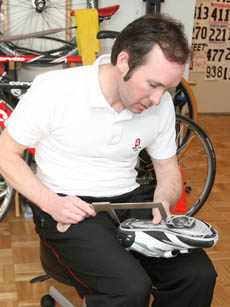 The fit begins with a brief interview, followed by a flexibility assessment. "There’s a general understanding of an acceptable range of movement of a rider’s limbs, and the flexibility assessment gives me a snapshot of a rider’s ‘functionality’ and a good idea of what type of position I may be able to put a rider in," explained Choat. In my case, he found that I had good flexibility in my glutes, but not my hamstrings, which jibes with my personal experience. My glutes scream in pain after TT’s while my quads and hamstrings are underused and unaffected. There’s also an extensive evaluation of the angle and tilt of your feet, and a cleat adjustment based on the findings. Interestingly, no body length measurements are taken. The fit is all about angles, not distances.
The fit begins with a brief interview, followed by a flexibility assessment. "There’s a general understanding of an acceptable range of movement of a rider’s limbs, and the flexibility assessment gives me a snapshot of a rider’s ‘functionality’ and a good idea of what type of position I may be able to put a rider in," explained Choat. In my case, he found that I had good flexibility in my glutes, but not my hamstrings, which jibes with my personal experience. My glutes scream in pain after TT’s while my quads and hamstrings are underused and unaffected. There’s also an extensive evaluation of the angle and tilt of your feet, and a cleat adjustment based on the findings. Interestingly, no body length measurements are taken. The fit is all about angles, not distances.
Next the LED’s are velcro’d and it’s time to hop on the bike. After doing a run in my initial position, my weaknesses are assessed and Choat goes to work. Choat says some ankling is necessary for maximum power, but I exceeded his preferred range of 30 degrees (10 heel down, 20 up) by 10. I’d always suspected that I ankled too much, so it was nice to have it proven with a quantifiable number. Choat then started moving my saddle around, trying to find a spot that would fix my pedaling. However, my ankling is so deeply ingrained that I unconsciously found ways to circumvent his fixes. Finally Choat decided to go with my natural tendency to ride forward on the saddle. He pushed the saddle forward and up (for a net loss in saddle height), and locked me in a position where I couldn’t point my toes. I instantly got the sensation of proper ankling, a whole new feeling for me. The run confirmed that I was now pedaling 8 degrees heel down and 20 heel up, right in the proper range.

Who, me ankle?
The rest of the fit focused on balancing the output between my quads, hamstrings, and glutes, and adjusting the front end for more comfort. My vanity likes my low bar height, so I was relieved that Choat didn’t raise my bars. He did, however, shorten my stem by 2 cm so that my upper arms sit at a 90 degree angle to my back, the better to support my weight. Choat is a big believer in having a relaxed upper body – core muscles will prioritize posture over breathing, so if you’re not comfortably supported in a neutral position, your breathing will be compromised.
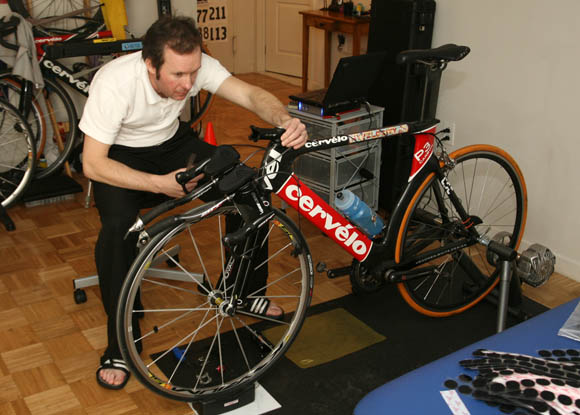
Choat mounts up a shorter stem. The Retül bar is visible just above his shoulder.
I put in a few rides (outside and on rollers) in the new position. Pedaling with less ankling felt more efficient, since my knees trace a smaller loop. Choat’s promise of spreading more work to my hamstrings hasn’t materialized yet, though my quads are much more sore after rides now. Going all out felt relaxed and powerful. Of course, I’m a weak minded easily suggestible sap, so take all that with a grain of salt. And yes, I did just use the word ‘powerful’ to describe myself.
 The subtext of so much stuff in cycling is the promise of free watts (free as in ‘you don’t have to train’ as opposed to ‘it costs nothing’), be it ceramic bearings, aero wheels, nutritional supplements, the wattage fairy, etc. Bike fit is no different: a good fit is supposed to let you ride longer, faster, more comfortably. I wish I could I could provide empirical data, but I’m coming off my annual month-long bout of winter bronchitis, so there’s no way I can assess whether the fit has improved my power output. However, I can state that being a skeptic, I walked into the fit determined to not let Choat alter my position. But I was so impressed with his breadth of knowledge I eventually went along with the plan. In the end I was happy to have learned some things and have some flaws diagnosed, so hope springs eternal for a faster upcoming season.
The subtext of so much stuff in cycling is the promise of free watts (free as in ‘you don’t have to train’ as opposed to ‘it costs nothing’), be it ceramic bearings, aero wheels, nutritional supplements, the wattage fairy, etc. Bike fit is no different: a good fit is supposed to let you ride longer, faster, more comfortably. I wish I could I could provide empirical data, but I’m coming off my annual month-long bout of winter bronchitis, so there’s no way I can assess whether the fit has improved my power output. However, I can state that being a skeptic, I walked into the fit determined to not let Choat alter my position. But I was so impressed with his breadth of knowledge I eventually went along with the plan. In the end I was happy to have learned some things and have some flaws diagnosed, so hope springs eternal for a faster upcoming season.
